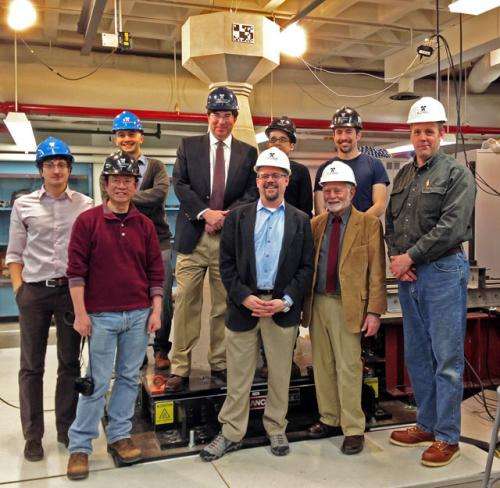Engineering an earthquake to buttress the National Cathedral

Two years ago when an earthquake struck the Washington, D.C. area, Robert Mark got a call from the master mason at the Washington National Cathedral. "The building is falling around me!" he said.
When it came time for repairs, Mark, a retired professor of civil engineering and architecture at Princeton and longtime consultant for the national landmark, turned for help to George Deodatis, the Santiago and Robertina Calatrava Family Professor of Civil Engineering and chair of the Department of Civil Engineering and Engineering Mechanics.
The two men, former colleagues, designed a life-size model of one of the 10-foot spires atop the neo-Gothic cathedral to see if it could withstand vibrations similar to those in 2011 that damaged several pinnacles, flying buttresses and a gargoyle, causing millions of dollars in damage to the structure. No one was injured.
What was different about the test model was that it had a steel rod inserted into its core for reinforcement, not the small bronze dowels that were supposed to hold the limestone spires together. To the delight of everyone who gathered in the lab on Feb. 12 for the simulated earthquake, nothing happened. The 2.5-ton pinnacle remained intact.
"The results of these tests are excellent news for all of us," said Deodatis. "Even though it didn't look very exciting, this is just how the earthquake occurred, and it's a good thing that the new pinnacle design didn't sustain any damage at all."
Founded in 1893, the research laboratory named in 1962 for Engineering alumnus Robert A.W. Carleton (CE 1904) has tested and monitored important infrastructure around the world for the past 50 years. For the cathedral project, the model was trucked to New York in pieces accompanied by cathedral stonemasons who reassembled the missile-like structure and inserted the rod in its center.
The spire was then placed on the lab's shake table, a custom-designed, 5-by-5-foot piece of equipment that can jiggle up to 6,000 pounds in a horizontal direction with three times the acceleration of gravity.
The day of the simulation, cameras and sensors were readied for the tests; a warning buzzer sounded; bystanders donned hard hats, and the table rocked back and forth. Each of the four test runs took all of 60 seconds – a total of two minutes.
The pinnacle is the largest object ever tested on the shake table, one of several specialized pieces of testing machinery at the lab. "This is an amazing piece of equipment," says Adrian Brügger, who manages Carleton Lab. "It's exciting to be able to help solve real-life problems on structures that define our daily lives and keep them safe for future generations."
During the simulation, Maria Feng, the Renwick Professor of Civil Engineering, tried out new sensors she developed that took remote measurements of the displacement response of the pinnacle to the seismic ground motion. Her advanced image-processing algorithm allowed her to use a single video camera to track the movements of multiple points along the entire height of the pinnacle. She also tested whether smartphone sensors can measure seismic response of structures. "We obtained highly comparable measurements, demonstrating the great potential of inexpensive ubiquitous smartphone sensors," she said.
Construction began on the cathedral in 1907 and finished in 1990. Cathedral officials say the repair work to the structure, the site of funeral and memorial services for nearly all U.S. presidents over the past century, could be completed in five years with the total cost estimated at more than $20 million.
"This collaborative effort between Washington National Cathedral and the Carleton Lab was an essential component for us to confirm how we should detail repairs for the cathedral moving forward," said James W. Shepherd, the cathedral's director of preservation and facilities. "We are trying to improve how the masonry elements might perform if another seismic event should occur."
Provided by Columbia University





















